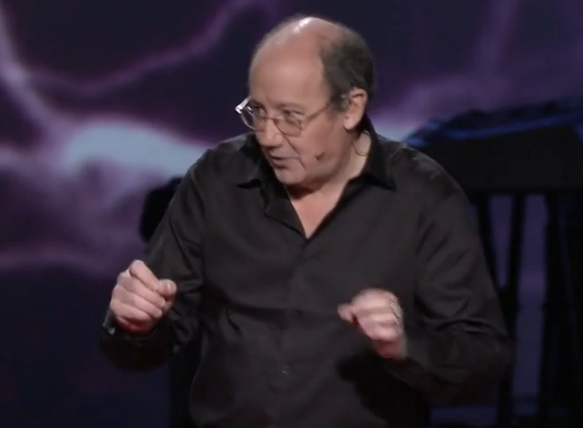So here's a great puzzle: in a universe ruled by the second law of thermodynamics,
所以,這就是個大謎團:在宇宙中,在被熱力學第二定律規范下,
how is it possible to generate the sort of complexity I've described,
怎么樣才有可能產生這種我剛才論述的那種復雜性
the sort of complexity represented by you and me and the convention center?
那種你,我和這個演講廳所呈現的復雜性?
Well, the answer seems to be, the universe can create complexity, but with great difficulty.
這答案似乎是,宇宙本生能創造復雜性,但是有極大的困難。
In pockets, there appear what my colleague, Fred Spier, calls "Goldilocks conditions"
總的來說,這種情況會發生,用我同事弗雷德·施皮爾的說法,“黃金條件”
not too hot, not too cold, just right for the creation of complexity.
不太熱,不太冷;就那么剛剛好能創造復雜性。
And slightly more complex things appear.
同時一些更加復雜的事情發生了。
And where you have slightly more complex things, you can get slightly more complex things.
就在那一點發生更加復雜的事,你可能發現更加復雜的東西。

And in this way, complexity builds stage by stage.
就這樣,復雜性就這樣一步一步的形成了。
Each stage is magical because it creates the impression of something utterly new appearing almost out of nowhere in the universe.
每個階段都是奇跡,因為它創造出了完全新的東西,出現在幾乎什么都沒有的宇宙中。
We refer in big history to these moments as threshold moments.
這個瞬間我們將標記為宏觀歷史中的起始瞬間。
And at each threshold, the going gets tougher.
在這些起始點,條件將更加苛刻。
The complex things get more fragile, more vulnerable;
復雜的東西變得更弱小,更脆弱。
the Goldilocks conditions get more stringent, and it's more difficult to create complexity.
黃金條件變的更苛刻,而且條件會變的更難來創造復雜性。
Now, we, as extremely complex creatures, desperately need to know this story of how the universe creates complexity despite the second law,
現實中我們是極度復雜的個體,渴望了解這個關于宇宙怎么創造復雜性的故事,不管那個第二法則,
and why complexity means vulnerability and fragility. And that's the story that we tell in big history.
以及為什么復雜性意味著脆弱和弱小。我們講的歷史這件事就是這個故事。
But to do it, you have do something that may, at first sight, seem completely impossible.
但是開始前,你必須做一些事,那些可能第一眼看起來完全不可能的事。
You have to survey the whole history of the universe. So let's do it.
你必須縱觀整個宇宙的歷史。那讓我們開始吧。











